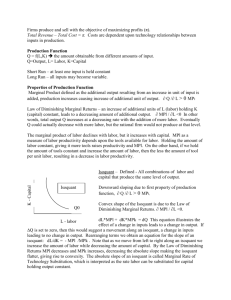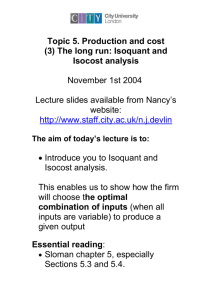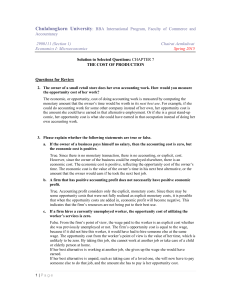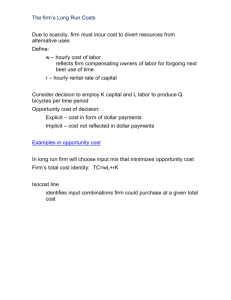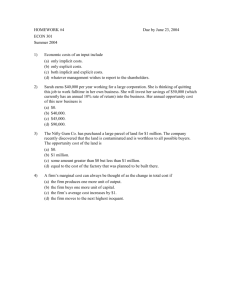Everything you need to know about isocosts and isoquants
advertisement
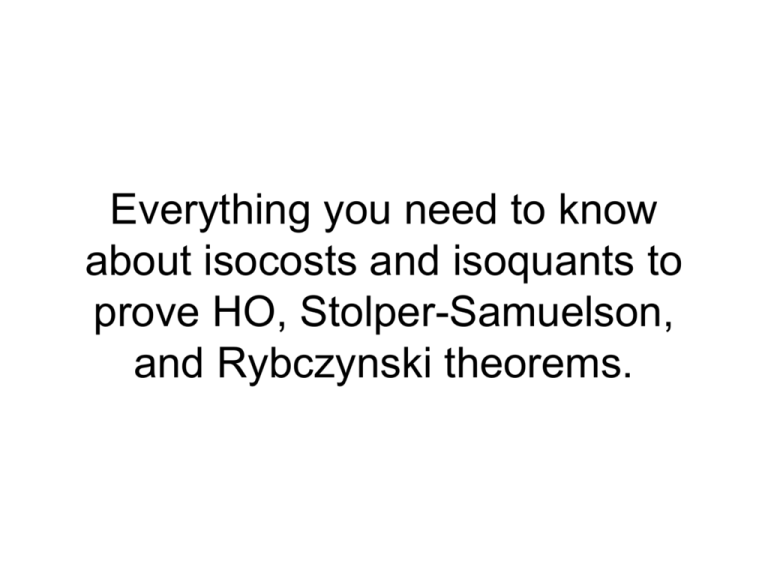
Everything you need to know about isocosts and isoquants to prove HO, Stolper-Samuelson, and Rybczynski theorems. The behavior of the firm • Firms are assumed to attempt to maximize profits. • First, the firm must identify the profit maximizing level of output – the quantity where marginal revenue equals marginal cost. • Next, the firm must minimize the cost of producing that level of output. • It must choose the appropriate technology and apply it correctly. As a part of this, it must combine resources according to the least-cost recipe. 2 Learning Objectives • Calculate and graph a firm’s isocost line • Work out how the isocost line changes when resource prices or total cost change • Make a map of production recipes (technology) using isoquants • Explain the choices that firms make • Prove three theorems relating to the HO model 3 A Cost Function: Two Resources • Assume that there are two resources, Labor (L) and Capital (K). • The money payments to these resources are Wages (W) and Rent (R). An isocost line is similar to the budget line. It’s a set of points with the same cost, C. Let’s plot K on the y axis and L on the x axis. WL + RK = C; solve for K by first subtracting WL from both sides. RK = C - WL; next divide both sides by R. K = C/R – (W/R)L; note that C/R is the y intercept and W/R is the slope. 5 An isocost line K (machines rented) C/R Absolute value of slope equals The relative price of Labor, W/R. C/W Labor hours used in production 6 A Numerical Example Bundles of: Labor Machine rental with C = $30 ($6 per labor hour) ($3 per machine hour) a 0 10 b 1 8 c 2 6 d 3 4 e 4 2 f 5 0 Points a through f lie on the isocost line for C = $30/hour. 7 Capital, K (machines rented) The Isocost Line 10 a b 8 c 6 d 4 e 2 f 0 1 2 3 4 5 6 7 8 9 10 Labor, L (worker-hours employed) 8 The Isocost Line • Wage-rental ratio – With K on the y axis and L on the x axis, the slope of any isocost line equals W/R, the wage-rental ratio. It is also the relative price of labor. • The y-intercept shows the number of units of K that could be rented for $C. • The x-intercept shows the number of units of L that could be hired for $C. 11 Capital, K (machines rented) Changes in One Resource Price 10 Cost = $30; R = $3/machine The money wage, W = ... a 8 6 A Change in W 4 2 0 …$6 …$10 1 h 2 3 f 4 5 6 7 8 9 10 Labor, L (worker-hours employed) 12 Capital, K (machines rented) Changes in Cost 10 A Change in Cost; every point between g and h costs $18. 8 6 g 4 2 W = $6; R = $3;C = $30 h 0 1 2 3 4 5 6 7 8 9 10 Labor, L (worker-hours employed) 14 Each point on a given isoquant represents different recipes for producing the same level of output. Capital, K (machines rented) An Isoquant 12 10 8 i 6 Quantity of Soybeans = 1 (kg./hour) 4 2 j 0 1 2 3 4 5 6 7 8 9 10 Labor, L (worker-hours employed) 17 6 7 8 9 10 m 4 5 Quantity of Soybeans = 2 (kg./hour) 3 k 2 j 1 Quantity of Soybeans = 1 (kg./hour) 0 Capital, K (machines rented) An Isoquant Map Different isoquants represents different levels of output. 0 1 2 3 4 5 6 7 8 9 10 Labor, L (worker-hours employed) 18 Capital, K (machines rented) Cost Minimization Choose the recipe where the desired isoquant is tangent to the lowest isocost. 12 10 a 8 C = $36 6 W = $6; R = $3;C = $30 4 equ. 2 C = $18 0 1 2 3 4 5 6 7 8 9 10 Labor, L (worker-hours employed) 21 Conclusion: Buy resources such that the last dollar spent on K adds the same amount to output as the last dollar spent on L. • The |slope| of the isocost line = W/R. • The |slope| of the isoquant = MPL/MPK – This will be demonstrated on the board. 22 Proof of the HO theorem (price definition). 24 Preparing to Prove the Heckscher-Ohlin theorem. In our example in class and the handouts, we demonstrated the theorem by assuming that Country A was relatively capital abundant, giving it comparative advantage in the capital-intensive good, S. Before we prove the theorem, study the figure above. Two isoquants are shown. Each represents all the technically efficient combinations of resources that could be used to produce one unit of a particular product. The isoquant for S lies closer to the K axis because S is the K-intensive good. The isoquant for T lies closer to the L axis because T is the L-intensive good. Only one isoquant is drawn for each good. However, our assumption of constant returns to scale means that the isoquant for two units of a good will require twice as much of each input. Thus the map of isoquants is regularly spaced. If we can prove a theorem for one output level, then it will be valid for all output levels. The assumption of constant returns to scale (and no fixed costs) also implies that average cost and marginal cost are constant and equal to each other for all levels of production. Note also that the assumption that both countries have access to the same set of technologies means that their isoquant maps are identical. 25 Proof of the Heckscher-Ohlin theorem. To prove the theorem from the price definition of factor abundance, we must show that a higher wage-rental ratio in A implies that B will have a lower autarkic relative price of T (and that A will have a lower autarkic relative price of S). Suppose that the autarkic relative price of S (PS/PT) in A equals 1. Then the line segment GH is the pre-trade isocost line facing A’s firms. Why? Given PS = PT and that P = MC = AC, the cost of producing one unit of S must equal the cost of producing one unit of T. Point G represents the following ratios: (MCSA = PSA = MCTA = PTA)/RA. By the same reasoning, point H represents the following ratios: (MCSA = PSA = MCTA = PTA)/WA . Thus the slope of the line connecting points G and H equals the pretrade wage-rental ratio in A, WA/RA. 26 Proof of the Heckscher-Ohlin theorem (continued) Now consider country B, which represents the labor-abundant country. Country B’s greater relative supply of labor means that it will have a lower autarkic wage-rental ratio. Two separate, parallel isocost lines are required to represent B’s optimal input choices for one unit of each good. These choices are represented by points X and Y. Note that the isocost line CX lies above the isocost line EY. Thus, the marginal cost of producing one unit of S in B is greater than the marginal cost of producing one unit of T in B. That is, MCSB > MCTB. Since price equals marginal cost, it follows that PSB > PTB. This is exactly what we were seeking to prove. That is, if the relative price of S in A equals one, then the relative price of S in B is greater than one. Thus A has a comparative advantage in S and B has a comparative advantage in T. 27 Proof of the Stolper-Samuelson theorem. Home is Labor abundant, T is Labor intensive. The initial isocost line is tangent to the S and T isoquants at F and D. $1 worth of each good costs $1 to produce. With trade PT/PS rises. (Assume only PT changes.) Note that W/R must rise proportionately more. 28 Proof of the Stolper-Samuelson theorem. When PT rises, Home will sell fewer units of T for $1. The new isoquant is T’. The new isocost line is tangent to the S isoquant at F’ and tangent to the T’ isoquant at D’. R’ < R. The money return to capital falls. PS is unchanged, but PT has risen. Thus the real return to capital falls. W’ > W. The money wage rises. Workers can now buy more S, as its price is unchanged. But can they buy more T? The increase in the wage rate is shown by the proportion (1/W)/(1/W’). This is greater than the proportionate increase in the price of T, which is the ratio of line segment 0D to 0R, 0D / 0R. The real wage in terms of T has also risen. Thus the real return to Labor rises. 29 Proof of the Stolper-Samuelson theorem (more words) The Stolper-Samuelson theorem states that the factor that is used intensively in a product whose relative price has risen gains, while the other factor loses. In the context of the HO model, this means that the abundant factor gains from trade while the scarce factor loses. Consider the figure. As before, we illustrate two isoquants representing $1 of output of S and T, respectively. Given the initial prices, wage and rental rates, the optimal combination of inputs are shown by points F and D. When trade is opened, the country with comparative advantage in good T will experience an increase in the relative price of T. At a higher price for T, $1 worth of this product would lie on a lower isoquant (remember that isoquants refer to physical units). Thus the T=$1 isoquant would become the isoquant labeled T’. If some of both goods are still to be produced, the $1 isocost line must rotate to maintain tangency with the two isoquants S and T’. How can this be accomplished? Wages and rents must change. The new isocost line has intercepts $1/R’ and $1/W’. Since the numerators of these fractions are the same as before, we can deduce what has happened to rents and wages by simply comparing 1/R with 1/R’ and 1/W with 1/W’. (continued on next slide) 30 Proof of the Stolper-Samuelson theorem (continued) In the first case, the fraction has risen. This could occur only if R’ < R, that is , if rents have fallen. On the other hand, a comparison of horizontal intercepts shows that W has risen. These changes in W and R are nominal changes. What has happened to the purchasing power of capitalists and laborers? For capitalists, the answer is straightforward. We have assumed that the price of S has stayed fixed while the price of T has risen. A fall in R, therefore, means that capitalists have lost purchasing power in terms of either product – they are definitely worse off when the price of the labor-intensive good T rises relative to the price of the capital-intensive good S. What about labor? The rise in W definitely means that labor can afford to purchase more S, because its price has been assumed to remain constant. However, the price of T has risen. Can labor buy more or less of this product? The answer is more. How do we know? Graphically, the increase in wages can be found by comparing the proportions (1/W)/(1/W’). This increase is greater than the proportionate increase in the price of T, which can be found by the ratio of the line segments 0D/0R. (Given CRS, the isoquants are evenly spaced.) This proves the theorem. 31 Notes on Stolper Samuelson Why does the ratio 0D/OR represent the proportionate increase in the price of T? This is a bit hard to see at first. Suppose that R and W (and C) rose by the same proportion as PT. Then the $1 isocost line would shift in (parallel) to be tangent at R. This lower quantity of T costs $1 to produce, and would sell for $1. Since price equals marginal cost equals average cost, the increase in cost at D (which now costs more than $1) will equal the increase in price. Thus 0D/0R represents the proportionate increase in price. 32 A more formal explanation: Why does the ratio 0D/OR represent the proportionate increase in the price of T? We know that PTT = P’TT’ (= $1). Divide both sides by PTT’ to get : T/T’ = P’T/ PT 0D = T and 0R = T’. T Thus 0D/0R = P’T/ PT, the proportionate increase in price. Looking at the graph reveals that W’/W > 0D/OR. Therefore, W’/W > P’T/ PT. Thus workers’ real wage has risen in terms of both T and S because the money wage has increased by more than the price of either good. 33 Proof of the Rybczynski theorem 34 Proof of the Rybczynski theorem The Rybczynski theorem states that if a country experiences an increase in its endowment of any one factor (say, labor), then, holding all other things constant (including factor and product prices), the output of the good that uses the factor intensively will rise, and the output of the other good will fall. To prove this theorem, refer to the isoquant map shown in the figure. Each of the two isoquants shown represents the output of $1 worth of one good, S or T. Suppose that the relative price of S is equal to 1. As discussed in the proof of the HO theorem, this must imply that there is an isocost line that is just tangent to the two isoquants, just as drawn. Furthermore, we know that the vertical and horizontal intercepts of this isocost line must equal $1/R and $1/W, respectively. The tangency points F and D determine the optimal input combinations to produce $1 of S output and $1 of T output. If wages and rental rates are held fixed, the assumptions of constant returns to scale guarantees that the slope of the rays from the origin passing through point F and D determines the optimal capital/labor ratios for the two industries, given those factor prices. (continued on next slide) 35 Proof of the Rybczynski theorem (continued) How does the economy divide its output between the two products? This depends upon the overall supply of available factors of production. Suppose that the economy is initially endowed with a set of factors defined by point E. To find the optimal production of S and T, complete the parallelogram from point E to the two rays emanating from the origin. This defines points G and H on the two rays. These points represent optimal production levels of S and T, given the prices prevailing in the economy. How do we know that this is true? First, we know that output must occur on the rays. Second, we want to use all available resources. If we add the factor combination represented by the line 0G to the point H, we reach the total endowment level E. Similarly, if we add 0H to G, we also reach point E. Now we are in position to prove the theorem. Suppose that the country’s endowment of labor rises, but capital and prices do not change. This pulls the country’s endowment point horizontally away form E to , say, E’. By completing the parallelogram with points E’ and 0 at the corners, we see that the optimal production levels of S and T have changed from their old levels. In particular, the output of S has fallen (to G’), while that of T has risen (to H’). This proves the theorem. 36

